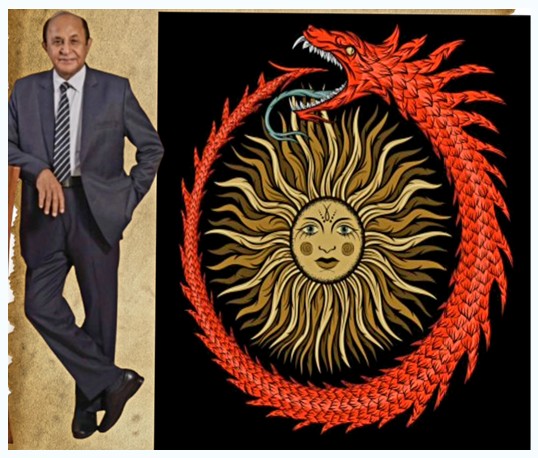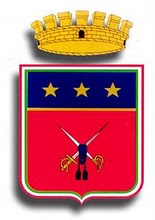di Krishan Chand Sethi
Prima di addentrarci nell’articolo, dobbiamo comprendere il significato della parola Ouroboros. È un antico simbolo che raffigura un serpente o un drago che mangia la propria coda, formando il cerchio della vita. Un serpente che divora la propria coda non è solo un’immagine insolita, è una ricca metafora che sopravvive a secoli di pensiero umano, filosofia e spiritualità. Questo Ouroboros è comparso nelle tombe egizie, nei testi alchemici greci, nella cosmologia induista e nella psicologia moderna. Ma perché, dunque, un serpente dovrebbe consumare se stesso? Quale potrebbe essere il significato dietro un comportamento così insolito?
In sostanza, l’Ouroboros è una rappresentazione visiva dell’eternità, della circolarità e della dipendenza tra fine e inizio. In questo articolo esploreremo il significato simbolico del serpente che consuma la propria coda, forniremo osservazioni filosofiche, similitudini comuni e riflessioni per stimolare il pensiero. Il nostro intento è indagare come questo concetto mitologico possa educarci sulla transitorietà della vita, la ricerca della realizzazione del sé e i paradossi dell’esistenza.
- La Storia: Origine dell’Ouroboros
L’Ouroboros è apparso per la prima volta nell’Antico Egitto intorno al 1600 a.C., come dipinto su una parete tombale nel Libro Enigmatico dell’Oltretomba. La figura raffigurava un serpente avvolto attorno al dio del sole Ra, simboleggiando la rinascita e la continuazione ciclica. Il simbolo fu poi utilizzato dagli alchimisti e dai filosofi greci. Per loro rappresentava la ripetizione ciclica della creazione e distruzione, una sintesi degli opposti, simbolo del filosofo. Lo stesso simbolismo del serpente si trova in India sotto forma di Ananta Shesha, il serpente cosmico infinito su cui riposa il Signore Vishnu tra le creazioni.
Nel mio Pensiero:
L’Ouroboros è qualcosa di più della riconciliazione tra l’inconscio e il conscio come lo vedeva Jung. Per me, è un simbolo vivente di auto-nascita e auto-morte—un ritorno del sé che si ricollega all’anima umana. {Carl Gustav Jung (1875–1961) è stato uno psichiatra e psicoanalista svizzero}
Non solo totalità, ma anche conflitto tra ciò che sono stato, ciò che sono e ciò che voglio essere. La coda è il passato—ciò che nutre o contamina. La bocca è la volontà—ciò che desidera mangiare, digerire o vomitare.Mangiare è una decisione quotidiana: imparare da, digerire, e rinascere me stesso.
Questo simbolo mi ricorda:
Tu sei il tuo inizio e la tua fine. Sei la domanda e sei la risposta. Il dolore e la guarigione. Il ciclo non è rotto; è rifatto. Ecco come comprendo l’Ouroboros: non come simbolo di unione, ma di trasformazione personale. È la fiamma dell’auto-illuminazione, lo specchio dell’auto-interrogazione e la mappa del divenire, che gira e rigira—non perché deve, ma perché sta progredendo.
Illustrazione: Immagina un fiume che si svuota nell’oceano, evapora, ricade come pioggia sulla terra, e rifornisce il fiume. La vita è circolare, e il serpente che si consuma è il fiume che realizza da dove è venuto
- Il ciclo di Nascita, Morte e Rinascita
Forse la spiegazione più generale dell’Ouroboros è il cerchio della vita. Mentre il serpente consuma la propria coda, la vita consuma la morte, e la morte genera nuova vita. Ci sono stagioni che vanno e vengono, imperi che sorgono e cadono, e il miglioramento personale tende a emergere dalle ceneri degli errori passati. Questo simbolismo è molto vicino alle filosofie orientali. Sia l’Induismo che il Buddhismo credono nel concetto di samsara, il ciclo di nascita, morte e rinascita. Il serpente, consumando se stesso, viene usato come simbolo del viaggio dell’anima attraverso infinite incarnazioni fino a raggiungere la liberazione (moksha o nirvana).
Suggerimento: Per vivere con uno scopo, dobbiamo riconoscere che le fini non sono fallimenti, ma aperture. Accetta il cambiamento come ritmo della vita. Il compito che finisce, il legame che muta, la perdita che trafigge—sono tutti momenti che sostengono un nuovo inizio.
- Unità degli Opposti: il paradosso di Distruzione e Creazione
I filosofi fin dai tempi di Eraclito si sono chiesti se gli opposti non siano solo collegati ma interdipendenti. L’Ouroboros lo rappresenta perfettamente: il serpente è sia divoratore che divorato, creatore e distruttore. Questo è un principio presente nello yin e yang del Taoismo, dove luce e oscurità esistono, si confondono l’una nell’altra e non possono essere complete senza la presenza dell’altra. Così, l’Ouroboros è un koan visivo—un paradosso che ci costringe ad accettare la dualità dell’esistenza.
Illustrazione: Pensa al fuoco che distrugge il legno ma ci dà anche calore ed energia. Se non brucia, non può mai trasformarsi.
Consiglio: In mezzo all’avversità, oltre a chiederti “Cosa si è perso?”, chiediti anche “Cosa sta diventando?” Accetta i paradossi, l’amore e la paura, la forza e la vulnerabilità, come crescita.
- Auto-riflessione e ricerca della Completezza
Carl Jung spiegò l’Ouroboros come metafora dell’individuazione, l’unione dell’ombra (inconscio) e della persona (sé conscio). Il serpente che si mangia viene rifatto come metafora del sé in cerca della completezza.
Questa è la via della completezza
Affrontando le nostre paure, i nostri desideri e le nostre ferite, diventiamo completi. L’auto-realizzazione non è perfezione ma integrazione, accettando tutto di noi stessi.
Suggerimento: Prenditi tempo per pensare. Medita. Scrivi. Fai terapia se ne hai bisogno. La via della completezza è quella del consumare la propria storia e rinascere più saggi.
- I pericoli dell’auto-consumo: quando il ciclo è una Trappola
Sebbene l’Ouroboros simboleggi la rinascita, avverte anche contro i cicli autodistruttivi. Dipendenza, relazioni abusive, fallimenti continui—tutti sono rappresentati dal serpente che si divora senza trasformazione. Questo ciclo è patologico. Ciò che doveva restaurare ora prosciuga. Il serpente ricorda a se stesso che nel divorarsi, deve espandersi, non restringersi.
Illustrazione: Immagina una persona intrappolata in un lavoro logorante che le consuma la vita ma ha troppa paura per lasciarlo. La fatica quotidiana consuma la persona poco a poco.
Consiglio: Osserva i modelli della tua vita. Sono sani o tossici? Rompi i modelli malsani facendo scelte intenzionali. Cerca aiuto. Trasforma l’Ouroboros da una trappola in una missione.
- Il Ritorno eterno: l’esperimento mentale di Nietzsche
Friedrich Nietzsche scrisse del ritorno eterno, la possibilità di dover rivivere la stessa vita più e più volte. Passeresti attraverso gioia e sofferenza all’infinito? {Friedrich Nietzsche (1844–1900) è stato un filosofo, critico culturale, poeta e filologo tedesco}. È esattamente così che opera l’Ouroboros. Ti fa fermare e riflettere: se la vita è circolare, sei soddisfatto del cammino che stai percorrendo?
Consiglio: Vivi con uno scopo. Fai cose di cui non ti pentiresti se le facessi per tutta l’eternità. Questo dà significato etico e definizione esistenziale alla vita.
- Interpretazioni moderne: Tecnologia, Ecologia e Società
Oggi l’Ouroboros si trova nei processi globali: cicli di feedback nell’economia, cicli nell’ecologia, dipendenze da web. È un avvertimento che l’uso non rinnovabile della natura, del tempo o dello spirito, finirà col consumarci.
Illustrazione: Il nostro sistema climatico globale riflette un ciclo ouroborico: l’uso industriale porta all’inquinamento, l’inquinamento porta alla crisi climatica, che minaccia le nostre industrie.
Consiglio: Sii sostenibile dal punto di vista ambientale, ma anche emotivo e mentale. Stai rigenerando ciò che consumi? Stai praticando modalità rigenerative o estrattive?
- Distruzione creativa: l’Ouroboros imprenditoriale
Nel mondo degli affari, la “distruzione creativa” è il nuovo che sostituisce il vecchio. Le startup sovvertono il pensiero tradizionale. Nuovi concetti scuotono i mercati. Anche questo è l’Ouroboros al lavoro—morte e rinascita nel sistema.
Consiglio: La reinvenzione non va temuta. Distruggi il vecchio pensiero affinché ne nasca uno nuovo. L’adattamento non è un tradimento del passato, ma un’estensione del tuo divenire.
- L’Ouroboros interiore: Consapevolezza e Presenza
La consapevolezza; essere qui e ora, è un modo per essere l’Ouroboros. Ogni momento passa e ognuno inizia simultaneamente. Il nostro respiro, mente ed emozioni sorgono e calano nei nostri infiniti cicli interiori.
Suggerimenti: Coltiva la consapevolezza. Osserva i tuoi cicli interiori: come la rabbia emerge e svanisce, la gioia sale e scoppia. La consapevolezza è pace.
- Metafora personale: diventare l’Ouroboros
Significa realizzare che siamo noi stessi i nostri più grandi creatori e peggiori distruttori. Possiamo rifarci o prosciugarci.
Suggerimenti: Chiediti ogni giorno: sto costruendo o demolendo me stesso oggi? Cosa in me deve morire affinché qualcosa possa rinascere?
Conclusione: Il Cerchio non è una Trappola, ma una Porta. Il serpente che mangia la propria coda non è un’immagine di disperazione, ma di speranza, a patto che siamo pronti a guardarla in questo modo. La vita è un cerchio, ma uno che non è chiuso. È una spirale, che gira per sempre, che gira sempre verso l’apprendimento, verso la guarigione, verso la crescita. In ogni fine, un seme di inizio. In ogni oscurità, una scintilla di alba. In ogni momento di consumo, il potenziale del rinnovamento. Allora non temiamo l’Ouroboros. Siamo l’Ouroboros; sofisticati, vigili, completi.
Dr Sethi K.C – (Autore)
Daman, India – Auckland, Nuova ZelandaIn
In English Language …
When A Snake or Dragon Swallows Its Own Tail
A Philosophical Analysis of the Ourboros Symbol
Before we go through the article, we need to understand the meaning of words Ourboros . It is an ancient symbol depicting a serpent or dragon eating its own tail, forming the circle of life
A snake devouring its own tail is not only an unusual image, it is a rich metaphor that outlives centuries of human mind, philosophy, and spirituality. This Ouroboros has turned up in Egyptian tombs, Greek alchemical texts, Hindu cosmology, and modern psychology. Why, though, would a snake consume itself? What could be the meaning behind such an unusual behaviour?
In essence, Orebro’s is a visual representation of eternity, circularity, and dependence of ends and beginnings. In this article, we will explore the snake consuming its tail symbolic significance and provide philosophical remarks, common similes, as well as musings to facilitate reflection. Our concern is to inquire how this mythological concept can educate us on the transience of life, the quest for self-realization, and life’s paradoxes.
- The History: Origin of the Ouroboros
The Ouroboros first appeared in Ancient Egypt around 1600 BCE as it was seen painted upon a tomb wall in the Enigmatic Book of the Netherworld. The figure depicted was that of a snake wrapped around the sun god Ra, symbolizing rebirth and cyclical continuation.
The symbol was later employed by the alchemists and the Greek philosophers. To them, it represented the cyclical repetition of creation and destruction, a synthesis of opposites symbol by the philosopher. The same symbolism of the serpent is found in India in the form of Ananta Shesha, the infinite cosmic serpent on which Lord Vishnu rests between creations.
In My Thought:
Ouroboros is something more than a reconciliation of unconscious and conscious halves as Jung saw it. To me, it’s a living symbol of self-birth and self-death—a turning of the self which loops back to human soul.{Carl Gustav Jung (1875–1961) was a Swiss psychiatrist and psychoanalyst}
Not only wholeness, but warfare amongst what I have been, what I am, and what I want to be.
The tail is the past—what feeds or contaminates. The mouth is the will—what wishes to eat, digest, or vomit.
To eat is a daily decision I make: to learn from, digest, and rebirth myself.
This symbol reminds me:
You are your own start and your own end. You are the question and you are the answer. The hurt and the healing. The cycle isn’t broken; it is remade.”
And that’s what I understand the Ouroboros as a symbol of personal transformation, rather than union. It’s the flame of self-illumination, the mirror of self-questioning, and the chart of becoming, going round and round again—not because you must, but because you’re progressing.
Illustration: Imagine a river emptying into the ocean, evaporating, raining back onto the earth, and replenishing the river. Life is circular, and the snake consuming itself is the river realizing where it came from. - The Cycle of Birth, Death, and Rebirth
Arguably the most general explanation of the Ouroboros is the circle of life. As the serpent consumes its own tail, life consumes death, and death begets fresh life. There are seasons that come and go, empires that rise and fall, and self-betterment has a tendency to emerge from the flames of previous error.
This symbolism is very much akin to Eastern philosophies. Both Hinduism and Buddhism believe in the concept of samsara, the cycle of birth, death, and rebirth. The snake, in consuming itself, is used as a symbol of the soul’s journey through endless incarnations until it achieves liberation (moksha or nirvana).
Tips: In order to live on purpose, we have to acknowledge that endings aren’t failures, but openings. Accept change as the rhythm of life. The task that ceases, the bond that mutates, the loss that pierces them – all moments sustaining a fresh beginning. - Unity of Opposites: Paradox of Destruction and Creation
Philosophers ever since Heraclitus have wondered if opposites are not only related but interdependent. The Ouroboros reduces this to a tee: the snake is both devourer and devoured, creator and destroyer.
This is a principle in Taoism’s yin and yang, where light and dark both exist, blur into one another, and can never be whole without the presence of the other. Thus, the Ouroboros is a visual koan–a paradox which compels us to accept the duality of existence.
Illustration: Consider fire that destroys wood but also gives us heat and energy. Unless it burns, it can never transform.
Advice: Amid adversity, as well as “What is lost?” also say “What is becoming?” Accept paradoxes, love and fear, strength and vulnerability, as growth. - Self-Reflection and the Pursuit of Wholeness
Carl Jung explained the Ouroboros as a metaphor of individuation, the union of the shadow (unconscious) and the persona (conscious self). The eating snake is refashioned as a metaphor of the self searching for wholeness.
This is the way of wholeness.
Confronting our fears, our lusts, and our wounds, we become whole. Self-realization is not perfected but integrated accepting all of us.
Tip: Take time to think. Meditate. Write. Get therapy if you need it. The way of wholeness is that of consuming one’s history and giving birth wiser. - The Dangers of Self-Consumption: When the Cycle Is a Trap
While the Ouroboros symbolizes rebirth, it also warns against self-destructive loops. Addiction, abusive relationships, continued failure, all are represented by the snake devouring itself without transformation.
This loop is pathological. What was meant to restore now depletes. The snake reminds itself that in devouring itself, it must expand, not shrink.
Illustration: Imagine a person trapped in a draining job that sucks the life out of them but is too afraid to leave. The drudgery takes its toll on them little by little.
Advice: Observe patterns in your life. Are they healthy or toxic? Break unhealthy patterns by making intentional choices. Seek assistance. Take the Ouroboros out of a trap and turn it into a quest. - The Eternal Return: Nietzsche’s Thought Experiment
Friedrich Nietzsche wrote of eternal recurrence, the potential for having to relive the same life repeatedly, time and time again. Would you go through the joy and the suffering ad infinitum?{Friedrich Nietzsche (1844–1900) was a German philosopher, cultural critic, poet, and philologist}
That is precisely how the Ouroboros operates. It makes you pause and reflect: if life is circular, are you satisfied with the path you’re traveling on?
Advice: Live with purpose. Do things you’d never be sorry for having done if you did them for all eternity. This gives life ethical meaning and existential definition. - Modern Interpretations: Technology, Ecology, and Society
Ouroboros today is in world processes: feedback loops in economics, cycles in ecology, web addictions. It’s a warning that non-renewable use of nature, time, or spirit, will eventually consume us up.
Illustration: Our global climate system reflects an Ouroboric cycle: industrial use leads to pollution, pollution leads to climate disruption, which in turn threatens our industries.
Advice: Be sustainable environmentally, of course, but also emotionally and mentally. Are you regrowing what you are using up? Are you practicing regenerative or extractive practices? - Creative Destruction: The Entrepreneurial Ouroboros
In business, “creative destruction” is new supplanting the old. Startups upend traditional thinking. New concepts shake markets. This, too, is the Ouroboros at work—death and rebirth in the system.
Advice: Reinvention is not to be feared. Destroy old thinking so new thinking can arise. Adaptation is not a betrayal of your past, but an extension of your becoming. - The Inner Ouroboros: Mindfulness and Presence
Mindfulness ;being here and now, is a way of being the Ouroboros. Every moment passes and every one begins simultaneously. Our breath, mind, and emotions rise and fall in each of our own endless cycles.
Tips: Cultivate mindfulness. Observe your inner cycles: how anger wells and ebbs, joy bubbles and bursts. Awareness is peace. - Personal Metaphor: Becoming the Ouroboros
It means to realize that we are our own greatest creator and worst destroyer. We can re-make ourselves or suck out our potential.
Tips: Ask yourself every day: Am I building or taking apart myself today? What in me must die so something can be reborn?
Conclusion: The Circle That Is Not a Trap, But a Doorway
The snake that eats its own tail is not an image of desperation, but one of hope, so long as we’re ready to look at it that way. Life is a circle, but one which is not shut. It’s a spiral, one that turns forever, one that turns ever toward learning, toward healing, toward growing.
In each end, a seed of start. In each darkness, a spark of dawn. In each devouring moment, the potential for renewal.
Then do not let us fear the Ouroboros. Let us be it; sophisticated, watchful, whole.
Dr Sethi K.C (Author)
Daman, India – Auckland, New Zealand



